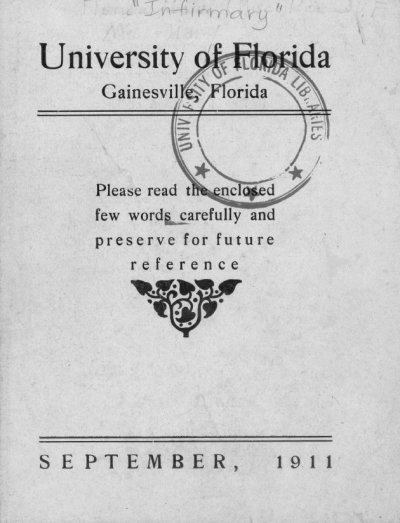
Malaria was the most common diagnosis made by the University Physician in 1910. The Physician was Professor Edward R. Flint (Ph.D., M.D.) who also taught chemistry. In academic year 1913, thirty-one of seventy-two patients seen by the Physician were malaria cases. In fact, the first patient examined by Dr. Flint after the University moved to Gainesville in 1906 was a malaria case. Quinine was the standard remedy. Flint also diagnosed several cases of Dengue fever, another mosquito born tropical disease.
Malaria was rampant for several reasons. The campus was constructed in a hammock environment that was prone to mosquito infestation, and the constant building construction created more places for water to collect and the mosquitoes to thrive. Campus sewage flowing into a marsh on the west end of campus was also a contributing factor. Screens were not placed on dormitory windows until 1911. Even after the screens were installed, an inspection of rooms in 1912 found an average of 30 mosquitos in each room. It was not until a drainage system was completed in the 1920s that the mosquito and malaria problems were alleviated.
Admission to the University of Florida was relatively simple in 1910. All white male applicants who completed the eleventh grade with sufficient credit hours in specific subject areas were admitted. There was no minimum GPA or SAT score. Unfortunately, though, many counties in Florida did not provide even a tenth grade education much less an eleventh or twelfth grade one. To compensate, UF also conducted a two-year subcollegiate program. There were 147 college students enrolled in 1910 and another 33 sub-freshmen. There was a teaching faculty of twenty-six. A twelfth grade education became the admissions requirement in 1912.
The curriculum was revamped in 1909 by the University's new president, Albert Alexander Murphree. Murphree created the first four academic colleges: the College of Arts & Sciences, the College of Law, the College of Engineering, and the College of Agriculture. Murphree also established a Graduate School. A fifth college, the Teachers' College (now the College of Education) was added in 1911. Although the College of Arts and Sciences had the highest enrollment, the College of Law awarded more degrees. Of the twenty-nine bachelor's degrees awarded in 1911, fourteen were in Law.
There were only four buildings on campus in 1910. Thomas Hall was used as a combination dining hall, gym, assembly hall, library, and classroom building. Buckman Hall was the dormitory, and Science Hall (now Flint-Keene Hall) was the classroom and laboratory building for the sciences. The Agricultural Experiment Station was located in Newell Hall. An engineering building was under construction and completed in 1911.
Technically speaking, there were no Florida Gators in 1910. The alligator was not accepted as the nickname for the varsity teams until 1911. There was, however, a student organization called the Bo Gator Club that came into existence in 1907. The leader of the club was the Chief Bo Gator, Neal S. Storter of Everglades City, who was also the center and captain of the 1911 football team. The Gator nickname probably derives from Storter's Bo Gators, although other explanations have been given.
The varsity teams practiced on a hard field full of sandspurs, roots, and even a tree stump. Few football games were played there, though. Instead, games were usually played in Jacksonville before improvements were made to the athletic field. The field was later named after Frank Fleming, a member of the Board of Control. Fleming Field was used until 1930 when Florida Field (now Ben Hill Griffith Stadium) opened.
The 1910 football team was led by Captain Earle "Dummy" Taylor. For the first time in its brief history, the team played more out of state opponents than in-state. The only defeat that year was to Mercer College of Macon, Georgia. Mercer was Florida's first sports rival, and games with the Mercer Bears were routinely scheduled in all sports throughout the 1910s and 1920s. The 1911 football team was even more successful than the 1910 team. Taylor had his best year and, along with Captain Bo Gator Storter, led the team to a 5-0-1 record. In 1912, Florida joined the Southern Intercollegiate Athletic Association and the schedules became much tougher. Still, the Gators managed winning seasons in seven out of nine seasons in the 1910s.
For more information on early student health care see Malaria, Bad Blood and Biliousness
Click on this and subsequent pages to read 1911 Infirmary pamphlet.
Back to the Timeline